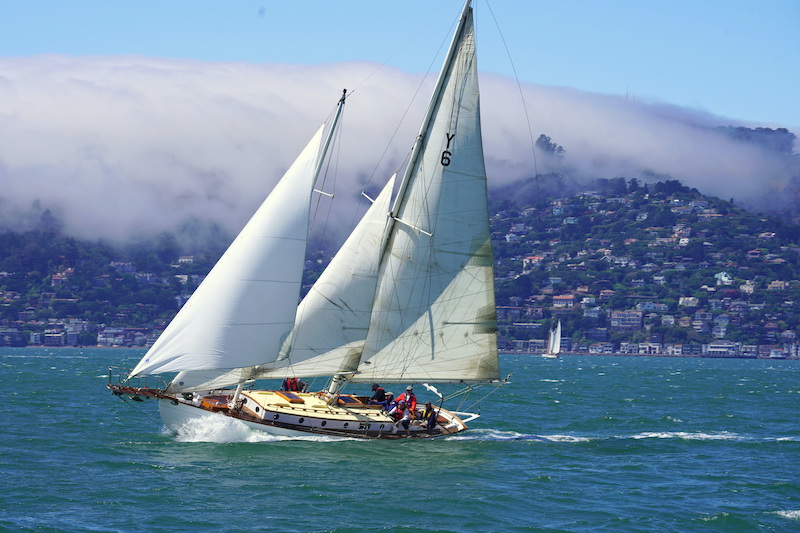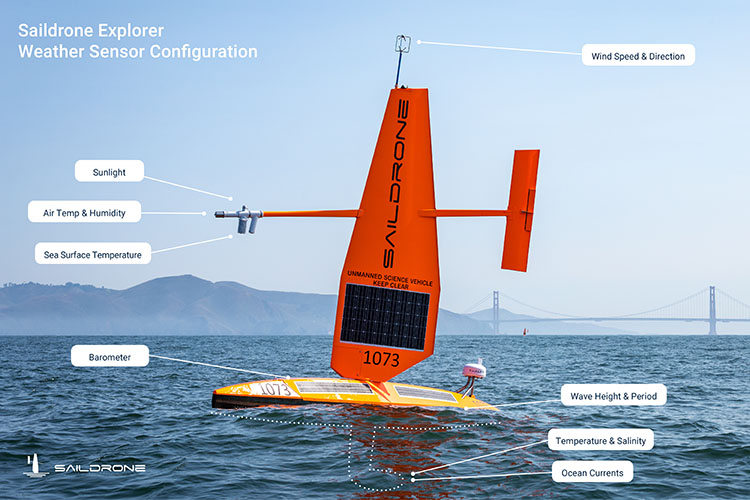
Classic Boats Roar Around the Bay in Belvedere Classic and Great S.F. Schooner Race
If you happened to be on the Bay or looking out from shore on Saturday, you might have seen the water awash with a fleet of beautiful sailboats. The Belvedere Classic Regatta and the Great San Francisco Schooner Race took place amidst outstanding Bay Area sailing conditions. “We had lots of wind, swirling fog and even some sun here and there … perfect summer day!” John ‘Woody’ Skoriak said after the race.

Racing took place on Saturday, with classic boats or those over 30-ft in length racing in four classes: Classic Yacht 1, Classic Yacht 2, Schooner, and a new class this year — Spirit of Tradition.

“We took first place in the Schooner Class on Seaward and had a blast,” Woody said.
Seaward was in good hands as she took to the course with a crew of old hands on deck — and we’re not just talking about their age. Woody called his shipmates “a veritable Call of the Sea ‘Dream Team’.”

The crew are all familiar with Call of the Sea and the schooner Seaward, in one way or another. Alan Olson co-founded Call of the Sea; David McGregor is a former Seaward captain. Taking turns on the helm was local high school student, video producer and “sailor extraordinaire” Omar Alami. (We featured Omar’s work in a recent ‘Lectronic.)
Former Call of the Sea board member Michael Seaman took care of the mainsheet while sailor Katie Jewett and Matthew Turner volunteer shipbuilder Pete McGinnis concentrated on the foredeck, helped by longtime Call of the Sea supporter Mat Lundberg and Zack Taylor, who tacked and trimmed the jib to keep Seaward ahead of the schooner fleet. Also on board was longtime Call of the Sea volunteer and photographer Benson Lee, whose photos have appeared numerous times in ‘Lectronic and Latitude 38 magazine.
“All of them helped to make the Classic and Great Schooner Race team one of the best,” Woody added.




“Considering none of us had sailed on Seaward for several years,” Woody added, “it was one of few times I’ve been on any boat and we didn’t make any mistakes, missed tacks, fumbled jibes, or even miss a mark! It was a great day of sailing!”
See the full results here.
West Coast Weather Buoy Replaced With Saildrone Vessel
What do sailors do when they’re not on a boat? Some like to keep an eye on the boats that are out and about. One such reader, Jean Ouellette, who also happens to be one of our editorial team, lives not far from the Gate and will sometimes check the vessel finder map to see which boats are in the vicinity. Recently, she noticed three Saildrones seemingly wandering around, tacking back and forth, offshore from Half Moon Bay and was curious about their purpose. We reached out to Saildrone, who told us that two of their vessels are doing regular testing, while the third is serving as a weather buoy in place of the standard fixed buoy.

Saildrone’s uncrewed vessel Explorer is currently serving off Half Moon Bay to gather information about wind speed and direction, air temperature, relative humidity, barometric pressure, sea surface temperature, significant wave height, and wave period. The information is delivered to NOAA’s National Data Buoy Center (NDBC), which operates more than 200 moored weather buoys around the globe. The difference is that Explorer doesn’t need to be anchored to the seafloor.
Explorer was deployed in August 2023 and has been delivering data since September 1, 2023.

NOAA’s National Data Buoy Center (NDBC) operates more than 200 moored weather buoys around the globe. They provide data for scientists to study the loss of sea ice in the Bering Sea and the impacts of ocean acidification on Florida’s coral reefs, and monitor the health of the Great Lakes.
“Moored weather buoys are both expensive and difficult to maintain — when outages occur, repairing them requires large, crewed ships and weeks at sea — and the moorings can impact fragile sea floor,” Saildrone explains on their website.
” … if they stay nearby, they’re testing. If they sail away, they’re going on mission :)” Saildrone candidly tells us.
Have you seen Explorer while sailing off the coast?
You can read more about Explorer and other Saildrone vessels here.
Choose North Sails for Maximum Performance and Lifespan
Another Circumnavigation Race — The McIntyre Mini Globe Race 2025
As the world builds ever-larger superyachts, there are many going in the other direction. If all goes according to plan, Don McIntyre, creator of the recently completed Ocean Globe Race and the Golden Globe Race, will fire the starting gun for the McIntyre Mini Globe Race 2025 at Antigua on February 23, 2025. It will signal the start for 19-ft one-design plywood racing boats to race around the world. Like many extreme events, it sounds insane, but there always seem to be people ready to take on a new challenge.

While the actual race is from Antigua to Antigua, the MGR will start with a qualifying leg from Lagos, Portugal, to Antigua. From there, the entrants will sail around the world westabout in four legs, heading west from Antigua to the Panama Canal and then following the traditional trade-wind route. Mass restarts will take place for each leg, the start date set for approximately two weeks after 25% of the fleet has arrived. An entrant MUST stop for at least seven days in a pit-stop port, but can stay longer with the clock restarting after seven days. An entrant can stop in any other non-scheduled port, but the clock keeps running. The 19-ft boats will be racing by Tahiti and Tonga. It could be pretty tempting for competitors to take a break and stretch their legs on a tropical island.

Race organizers predict the race will take entrants about 400 days to complete! Though they are not sailing south of the great capes in the Southern Ocean, it will be a long and challenging journey. At present there are 18 entrants listed, 16 men and two women, with one, Joshua Kali of Olympia, WA, from the US.
We’re now in what seems like a rare gap in the continuous flow of races circumnavigating the world. The McIntyre Mini Globe Race adds one more level of extreme global circumnavigation races to a growing menu of options. We look forward to seeing who makes the starting line and who’s got the stamina and drive to sail for 400 days in a 19-ft boat.
The 37th America’s Cup Is Right Around the Corner. Will You Be Watching?
Here’s a question that we seriously contemplated when we wrote about the America’s Cup in the August issue’s Sightings: Does the Latitude audience know that the 37th America’s Cup is about to begin? Does our audience care?
Here’s what we know our audience says almost any time we post a story (especially on social media) about the Cup (these are actual quotes): “The America’s Cup is lame now. Sorry. Bring back the Js, the 12-Meters or the IACC boats.” “It’s almost like NASCAR now, watching people go around in circles until someone crashes.” That last comment was actually about SailGP, but plenty of people have called both events NASCAR-esque. We don’t entirely disagree — we too have a little foiling fatigue. (If you’ve seen one boat rip around the water at 50 knots, you’ve kind of seen them all.)
Here’s the goal of this particular story: We want to raise the level of discourse beyond these knee-jerk reactions about the Cup. Let’s do better than “the old days were better” or “the new days are better,” and dig deep into our memories, desires for what the Cup should be, and our notions that have been challenged.

The 37th America’s Cup kicks off with a preliminary regatta — and the debut of this event’s AC75 foiling monohulls — from August 20 to 25. The Louis Vuitton Cup round robin begins on August 29 and goes into early October; the America’s Cup Finals are in mid-October. Defending champions Emirates Team New Zealand took the Cup to the highest bidder in Spain. Five teams will compete to challenge the Kiwis for the Cup, including the US with the New York Yacht Club’s American Magic, the United Kingdom’s INEOS Britannia, Switzerland’s Alinghi Red Bull Racing, Italy’s Luna Rossa Prada Pirelli and France’s Orient Express Racing Team.
Here is a defense of the modern America’s Cup: There are more lead changes than in the displacement era, where whoever won the start went on to win the race some 85% of the time. The graphics nowadays are absolutely amazing, and the onboard cameras capture every moment. Here are critiques of all those attributes: The graphics separate the event from their natural setting and conditions — which, as sailors, we can all hopefully agree are the main characters. Neither the Cup nor SailGP races in particularly sporty conditions, so the race track itself is flat in both wave action and personality.
Lead changes or no, the Cup Finals have always been a bit one-sided. Of the 37 America’s Cups over nearly two centuries, only three Matches have not been blowouts: In 1920, Resolute beat Shamrock IV three races to two. Dennis Conner and Liberty lost to Australia II 3-4 in 1983. In 2013, right here on San Francisco Bay, Oracle Team USA came back from 1-8 down to beat Emirates Team New Zealand 9-8 in one of the most exciting sporting events we’ve ever seen. Every other America’s Cup Final has seen one team dominate the other, the race likely won years before on the computer and in the boatyard, rather than on the water.
Though there are exceptions, there is a scripted nature to America’s Cup that makes it all feel a bit perfunctory. While the speed is phenomenal and a feat of technology and innovation, it blurs together, creating monotony. (To be fair, all professional sports have a monotonous quality if you watch long enough.)

We are incredibly excited to see the debut of the Puig Women’s America’s Cup from September 28 to October 13, where 12 teams will compete in foiling AC40s in both fleet and match racing. Maybe it’s the newness of the event or the stacked field, but we’re looking forward to seeing something a bit off script.
What are you looking forward to seeing at this year’s America’s Cup? Are you anti-foiling but pro-sailing? (Or vice versa?) Are you glad that the Cup is no longer sailing in “lead mines?” Do you appreciate that in the foiling era, more people are watching sailing? Have you been converted from the old school to the new?
Please comment below or email us here, and please strive to raise the level of debate.


